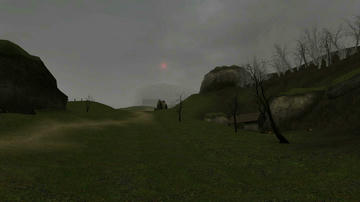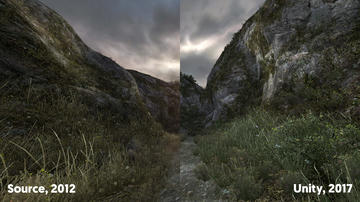Dear Esther: Landmark Edition
The Chinese Room, 2017

It’s nearly ten years since the original Dear Esther was released, and nearly 5 years since the commercial version changed the landscape of storytelling in games. Now The Chinese Room bring last year’s Unity console port to the PC, and add a long awaited developer commentary to this definitive edition of the classic game.
I didn’t play the original scrappy half-life mod of Dear Esther. I discovered it much later in 2010 after stumbling across Robert Briscoe’s blog about upgrading the game to use Source 2. Playing it was such an unexpected experience: a poetic, melancholy journey through the mind of a dying man who has lost his life’s love in a tragic accident.
Although unusual, and memorable in many ways, the original mod didn’t leave a great impression: visually it was unremarkable, using stock Half-Life textures and models, but I was curious about the use of a game engine to tell a story in this way.

Two years later when the upgraded version was finally released, my reaction was somewhat different. I was absolutely blown away, and deeply moved by the experience. I’m not sure what changed in those two years, but it’s fair to say I had been quite closed off emotionally for many years and I was finally opening up. I was in the second year of a new relationship and one which was clearly going to be for good.
Perhaps as a result, I was now more open to emotional experiences. Perhaps Dear Esther was even a catalyst in helping me grow, or maybe I was growing already, but either way the 2012 release of the game had quite a profound effect on me. This time, the story resonated with me much more and although I wasn’t sure I fully understood it, I was very moved by it. I’m sure Jessica Curry’s remastered score had a lot to do with it, a soundtrack I still listen to frequently.

So what’s new in the Landmark Edition? In terms of gameplay and story: not a lot really, at least none that I could tell. And if anything the switch to the Unity engine is a tiny downgrade for us PC players. The visuals have changed somewhat: the colour grading seems slightly different, and the level of detail filtering is higher which makes the game appear ever-so-slightly blurry compared to the Source version. Personally I prefer sharper graphics, so it’s a bit of a shame that this Landmark edition doesn’t look as good as the previous one. However I can completely understand why the port to Unity was done: firstly to get the game out for console players, and secondly it’s more likely to last running on this engine – who knows how much longer Source will be around? But it’s a minor niggle: the island is as bleak and beautiful as ever and the brooding atmosphere created through Briscoe’s art direction is still absolutely arresting and sublime.
The main thing that interested me this time around was getting the director’s commentary, and I played through the complete game again to listen to it. It’s fantastic.
There’s a wealth of insight here that I simply had not picked up on while playing the game originally and I finally understand some of the more puzzling aspects of the story. Dan, Jessica and Robert discuss everything from the inspirations of the game, the technical challenges, the music and the underlying themes. In fact, it’s clear that the amount of thought that went into the story and the writing was far greater than I’d ever imagined. So many more layers are revealed through their conversations, and I’d really recommend that any Dear Esther fan take the time to listen to the complete commentary: you’ll learn so much. Fun fact: the name Dear Esther and the germ of the idea for the game actually comes from the lyrics of a Faith No More song!

The Chinese Room have been incredibly generous. Players who already owned Dear Esther on Steam have been given this new version for free, which is a wonderful gift. It’s fantastic to see developers doing this, supporting their games and the fans years after the game has already made most of its money. They didn’t need to do that at all, so it’s a wonderful gesture.
Overall this is a great addition to the legacy of Dear Esther. The developer commentary is incredibly interesting and it’s well worth spending the two hours to listen to it all. I’ll still go back and play the Source version for the slightly better visuals, but you can’t go wrong with the Landmark Edition if you’re looking for more Dear Esther. Great stuff.